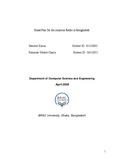Band plan for the amateur radio in Bangladesh
Abstract
A band plan is a plan for utilizing a particular band of radio frequencies that are a portion of the electromagnetic spectrum. Each band plan defines the frequency range to be included, how channels are to be defined, and what will be carried on those channels. An Amateur Radio Band Plan is an arrangement of how to use radio frequencies.
Amateur radio frequency allocation is done by national telecommunications authorities, in our case, it should have been done by Bangladesh Telecommunication Regulatory Commission. Globally, the ITU oversees how much radio spectrum is set aside for amateur radio transmissions.
In 2001 the National Frequency Allocation Plan was made and adopted in 2004 by BTRC. The commission allocated HF and VHF, UHF frequency range for HAM, but merely specified any details.
Radio amateurs use a variety of transmission modes, including Morse code, radioteletype, data, and voice. Specific frequency allocations are a matter of record and vary from country to country and between ITU regions as specified in the current ITU HF frequency allocations for amateur radio.
In our thesis we are aiming to come up with the band plan for amateur radio in Bangladesh. The proposal contains the distribution of amateur frequency to set the first such footing towards an effective utilization of the allocated frequencies. The proposed band plan is in accordance with the National Frequency Allocation Plan (NFAP) of Bangladesh, compatible with International Amateur Radio Union Region 3 (IARU R3) countries and it is done after taking consideration of our technology and resource.

